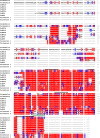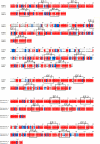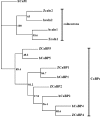Bioinformatic analysis of CaBP/calneuron proteins reveals a family of highly conserved vertebrate Ca2+-binding proteins
- PMID: 20426809
- PMCID: PMC2873350
- DOI: 10.1186/1756-0500-3-118
Bioinformatic analysis of CaBP/calneuron proteins reveals a family of highly conserved vertebrate Ca2+-binding proteins
Abstract
Background: Ca2+-binding proteins are important for the transduction of Ca2+ signals into physiological outcomes. As in calmodulin many of the Ca2+-binding proteins bind Ca2+ through EF-hand motifs. Amongst the large number of EF-hand containing Ca2+-binding proteins are a subfamily expressed in neurons and retinal photoreceptors known as the CaBPs and the related calneuron proteins. These were suggested to be vertebrate specific but exactly which family members are expressed outside of mammalian species had not been examined.
Findings: We have carried out a bioinformatic analysis to determine when members of this family arose and the conserved aspects of the protein family. Sequences of human members of the family obtained from GenBank were used in Blast searches to identify corresponding proteins encoded in other species using searches of non-redundant proteins, genome sequences and mRNA sequences. Sequences were aligned and compared using ClustalW. Some families of Ca2+-binding proteins are known to show a progressive expansion in gene number as organisms increase in complexity. In contrast, the results for CaBPs and calneurons showed that a full complement of CaBPs and calneurons are present in the teleost fish Danio rerio and possibly in cartilaginous fish. These findings suggest that the entire family of genes may have arisen at the same time during vertebrate evolution. Certain members of the family (for example the short form of CaBP1 and calneuron 1) are highly conserved suggesting essential functional roles.
Conclusions: The findings support the designation of the calneurons as a distinct sub-family. While the gene number for CaBPs/calneurons does not increase, a distinctive evolutionary change in these proteins in vertebrates has been an increase in the number of splice variants present in mammals.
Figures





References
-
- Bootman MD, Lipp P, Berridge MJ. The organisation and functions of local Ca2+ signals. J Cell Sci. 2001;114:2213–2222. - PubMed
LinkOut - more resources
Full Text Sources
Research Materials
Miscellaneous

